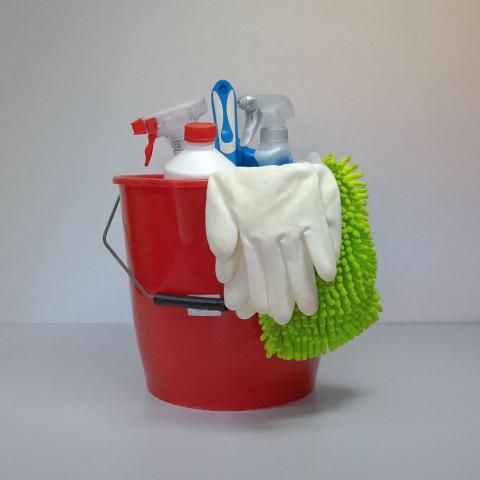Cleaning, Sanitizing and Disinfecting of Surfaces: Part Two

What to Clean, What to Sanitize and What to Disinfect
The differences between cleaning, sanitizing and disinfection were described in Part One. The online guidance for using these steps can be confusing because the terms sanitizing and disinfecting are sometimes used as if they mean the same thing. This post will explain when, where and how each step should be used.
At Home — When no one is ill
According to CDC guidance, when no one is ill with COVID-19, cleaning frequently touched surfaces daily is adequate for in-home protective measures to prevent virus spread via surfaces
In Food Businesses (farms, farm stands, restaurants, food processors) — When no one is ill
USDA guidance recommends that the same sanitary procedures that establishments are already following to protect food safety will also help prevent the spread of respiratory illnesses like COVID-19.
For farms and farm stands, this would mean continuing to follow the food safety and hygiene procedures already in place for keeping produce hygienic and safe. Farm food safety plans may include washing, rinsing, and sanitizing food contact surfaces and tools such as knives before and after use.
For food businesses such as restaurants and food processors this would mean following the Food Code regulations and Sanitation Standard Operating Procedures (Sanitation SOP) that they have developed and implemented to prevent contamination or adulteration of product. This FDA guidance has additional details.
High Touch Surfaces
The main way this disease spread is person-to-person through respiratory droplets. Cleaning and disinfecting steps will reduce the risk for the spread via contaminated surfaces even more.
The good news: these strategies also reduce the potential for spreading familiar bad bugs that cause foodborne illness such as E. coli, Salmonella, hepatitis A and norovirus.
CDC recommends At least once a day cleaning and disinfecting of surfaces frequently touched by multiple people: door handles, desks, phones, light switches, and faucets, baskets, steering wheels, POS equipment, etc. More often than this is also acceptable and may be welcomed by customers.
Clean visibly dirty surfaces with soap and water prior to disinfection.
Many disinfection product labels recommend keeping the surface wet with the product for a period of time. This may vary from one to 10 minutes or more, depending on the product formulation. Read and follow label instructions.
At Home — When someone in the home is suspected or confirmed to be ill with COVID-19
If someone in the home is suspected or confirmed to be ill with COVID-19, CDC recommends additional daily cleaning and added disinfection of high-touch surfaces in household common areas (such as tables, hard-backed chairs, doorknobs, light switches, phones, tablets, touch screens, remote controls, keyboards, handles, desks, toilets, sinks).
In Food Businesses (farms, farm stands, restaurants, food processors) —When someone is suspected or confirmed to be ill with COVID-19
In addition to the added cleaning and disinfection of areas and items the worker or customer may have contaminated, CDC recommendations include these cleaning and disinfection steps:
If surfaces are dirty, they should be cleaned using a detergent or soap and water prior to disinfection. If a surface is not visibly dirty, you can clean it with an EPA-registered product that both cleans (removes germs) and disinfects (kills germs) instead. Be sure to read the label directions carefully, as there may be a separate procedure for using the product as a cleaner or as a disinfectant.
For disinfection, most common EPA-registered household disinfectants should be effective, paying special attention to whether the products are recommended for the kind of surfaces you are using the disinfectant on.
If the ill person contaminated food contact surfaces, equipment or utensils, those surfaces should be disinfected and then rinsed and sanitized before being used for food preparation.
A list of products that are EPA-approved for use against the virus that causes COVID-19 is available.
Follow the manufacturer’s instructions for products for concentration, application method and contact time, etc. for all cleaning and disinfection products.
Did You Know?
Depending on the rate or concentration a chemical is mixed at, it can serve as a food-contact sanitizer or a non-food safe disinfectant.
For example:
One tablespoon of 5.25% strength bleach in one gallon of water would result in a food contact surface sanitizer. It would have an approximate concentration of 200 ppm, or parts per million, the maximum strength you would use for a food grade sanitizer. Effective food contact surface sanitizer strength for a bleach solution ranges from 50-200ppm.
Five tablespoons (1/3 cup) per gallon of water of that same 5.25% strength bleach can be made disinfectant strength, meant to be used on high touch surfaces (but not on food contact surfaces). This would make an approximately 1000 ppm disinfectant bleach solution (per CDC).
Resources -General
The Chlorine Dilution Calculator uses the concentration of the bleach product you are using and the concentration you want, to help you to determine how to dilute the bleach properly.
Using disinfectants to control the COVID-19 virus from the National Pesticide Information Center
Resources -Home
Cleaning, Sanitizing and Disinfecting in the Home from University of Pennsylvania Extension
Resources for Food Businesses
Guidelines for the Use of Chlorine Bleach as a Sanitizer in Food Processing Operations from Oklahoma Cooperative Extension Service
Guidelines for Disinfecting and Sanitizing with Bleach Solution based on bleach strength from Washington State Department of Health
Food industry resources from the Institute for Food Safety at Cornell
Poster on how to clean and disinfect high touch surfaces
Poster on how to clean and sanitize dishware and cooking utensils
Poster on how to clean and sanitize food contact surfaces
Farms
Farm Food Safety— Cleaning and Sanitizing Food Contact Surfaces from UNH Extension
A Guide to Cleaning, Sanitizing, and Disinfecting for Produce Farms from the University of Vermont Extension
Retail Establishments
The Food Marketing Institute (FMI) worker and customer safety toolkit for safety and sanitation practices in grocery stores.
Food and Beverage Issues Alliance protocol when a person who is ill with COVID-19 is in the facility is specific to food manufacturing facilities, distribution centers, and wholesale and retail outlets and is recommended by FDA .
Managing Operations in a Foodservice Establishment or Retail Food Store
